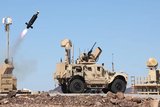Air Warfare magazine: sixth-generation fighters, airborne networking and more
Read the first edition of Air Warfare for free in our app or on your desktop. Register below to be sent the download link and receive future editions direct to your inbox.
Comment
Finland's insistence on practical flight trials to prove the capability of the aircraft bidding for its HX fighter requirement could prove a salutary lesson for other defence programmes.
Features include:

Gloves off?
The global MALE UAV market has evolved into an effective three-way contest between US, Israeli and Chinese suppliers. As the technology reaches its fifth generation, Shephard analyses how cost, capability and export controls are impacting on who buys what from whom.

Home advantage
While most Asian nations still rely on imported combat aircraft, an increasing number are looking to go it alone with indigenous design and production.
Other features include:
Cloud formation
As the UK-led Team Tempest and Franco-German Future Combat Air System projects ramp up, Shephard assesses how industry is preparing to bring such advanced concepts as combat clouds and remote carriers to life.
Staying on top
Ageing fleets in many nations and a heightened regional threat environment could lead to an increase in naval helicopter procurement in Asia-Pacific. Shephard Defence Insight breaks down the numbers.
Changing planes
The transition of a pilot from a potentially ‘dated’ aircraft to a next-generation platform with state-of-the-art capabilities brings with it a range of benefits and occasional challenges. Shephard spoke to US military aviators to get a feel for the process.
Strike action
Modern air defence networks are presenting an increasingly complex set of obstacles that missile designers must overcome to ensure that a target is hit.
Ironing it out
Development problems have plagued tactical and strategic transport aircraft from meeting operators’ expectations, but as models continue to earn their stripes, signs are strong that capabilities can be improved.
Staying on air
Facing the prospect of operations in heavily jammed environments, Western militaries are re-examining their airborne communications needs.

More from Air Warfare
-
![How do we detect and defeat enemy drones?]()
How do we detect and defeat enemy drones?
Learn about the portfolio of sensors and effectors for the complete counter-UAS mission at Raytheon, an RTX business.
-
![BAE Systems lauds counter-UAS drone progression with live fire trials]()
BAE Systems lauds counter-UAS drone progression with live fire trials
The US-based tests successfully demonstrated the first live trial of a precision guided missile from a modified TRV-150 drone which destroyed both aerial and ground targets.
-
![India readies private sector push as AMCA moves towards 2028 prototype]()
India readies private sector push as AMCA moves towards 2028 prototype
India’s stealth fighter ambitions gain fresh momentum as HAL opens the door to private sector involvement in AMCA Mk1A structural assembly, with strategic support growing for next-gen propulsion and sensor technologies.
-
![BAE Systems reveals new GCAP demonstrator design with plans to fly by 2027]()
BAE Systems reveals new GCAP demonstrator design with plans to fly by 2027
A key part in the trinational Global Combat Air Programme (GCAP), this is the first crewed supersonic aircraft demonstrator to be built and developed in the UK in more than 40 years.
-
![Kratos Defense makes European CCA push with Airbus partnership]()
Kratos Defense makes European CCA push with Airbus partnership
Kratos’ XQ-58A Valkyrie will be equipped with an Airbus-made mission system to be offered as a ‘European’ collaborative combat aircraft option to the German Air Force.
-
![Anduril’s Barracuda-100M completes latest successful test flights]()
Anduril’s Barracuda-100M completes latest successful test flights
The munitions variant of the Barrauda-100 autonomous air vehicle is being tested for the US Army’s High-Speed Manoeuvrable Missile (HSMM) testbed programme, with further flight tests expected in 2026.






















